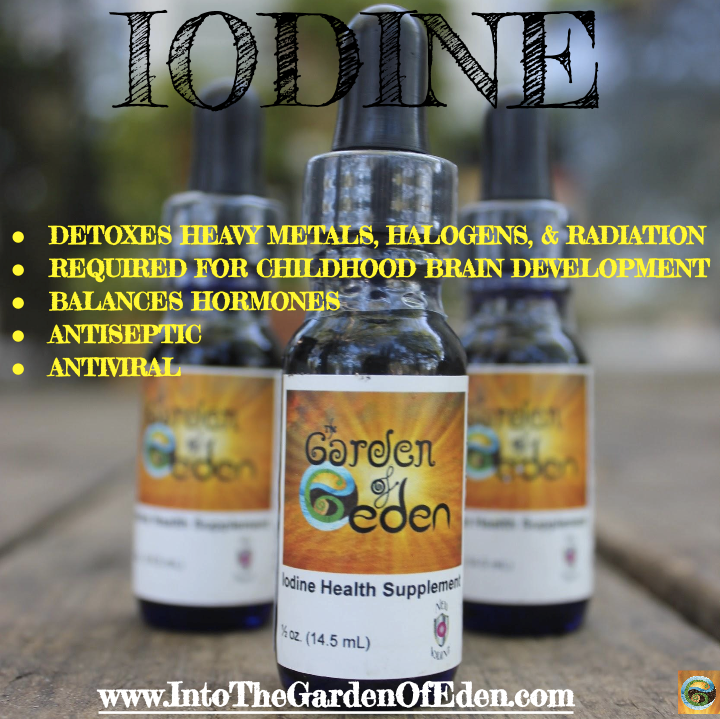Let us introduce you to the 53rd element on the periodic table.
- Iodine is a vital nutrient that must be consumed daily.
- 95% of the population does not take enough iodine.
- Full thrival is severely compromised if there is not enough iodine in the body.

As a building block for hormones, iodine is a vital nutrient required by every single cell in the body for optimal function.
Iodine is also responsible for:
- Healthy thyroid and hormone function
- Regulating metabolism
- Boosting energy levels
- Fighting infection
- Regulating blood sugar
- Reducing body odors
- Improving cognitive function
- Proper development in children and expectant mothers
- Normal immune function
- Purifying water
- Killing parasites, bacteria, mold, yeast, protozoa, viruses
- Detoxifying heavy metals, halogens, and radiation
Iodine is super important!! It regulates cellular nutrient uptake and waste expulsion, yet 95% of Americans are deficient in iodine.
Almost the entire population is operating at sub-optimal levels for health and wellness day in and day out because they are not providing proper inputs like iodine for their bodies!
While the body needs iodine to optimize every single chemical reaction that takes place, it does not make iodine. You have to include it in your diet--but the standard western food supply is no longer a reliable source of proper amounts of iodine. Modern agriculture practices have stripped the soil of iodine, and health-optimizing levels of this nutrient have not been abundant for decades.
Uncooked, unprocessed sea vegetables are one of the only reliable food sources of iodine anymore...but we don’t know a lot of Americans who are consuming raw seaweed on a daily basis.
(A note on iodized salt: Morton began marketing iodized salt to prevent goiter in the 1920s. However, it is not a form of iodine that is very accessible to the body. Additionally, the manufacturing process actually adds toxic substances! While goiter rates did decrease as people consumed Morton's salt, A) more healthful sources of iodine are available, B) many people are encouraged to follow low or no salt diets, and C) even if one takes iodized salt, generally the population is still not consuming the optimal form or amounts of iodine to maximize health.)
The FDA recommends 150 mcg of iodine per day, but this is only the bare minimum to prevent goiter, NOT the amount one needs for real thrival!
Plus, women and expectant mothers need significantly higher amounts, as iodine is vital for proper brain development of the unborn fetus and growing children.

Given the rampant deficiency within the population and its importance to full health, proper iodine supplementation is imperative!
The Japanese population regularly consumes 5,000-13,000 mcg on a daily basis because of their ocean-centered diet, and they enjoy superior health to Americans with lower rates of obesity, cancer, diabetes, thyroid disease, and cystic conditions.
There are many forms of iodine! Some are absolutely vital to health as the body can uptake and integrate them immediately, and others (like elemental iodine) are actually toxic to the human organism.
While we’re here on Steemit, we’re dedicated to helping as many people as possible. We offer our years of research and hundreds of testimonials to the efficacy of NASCENT IODINE and its power to optimize health and eradicate disease!
We’ll expand on many of these issues in upcoming posts and address specific diseases and conditions that iodine supplementation benefits.
http://articles.mercola.com/sites/articles/archive/2011/03/25/how-to-protect-yourself-from-nuclear-radiation.aspx
http://www.laurapower.com/page26.html
Dr. David Brownstein. Iodine: why you need it, why you can’t live without it. 3rd Edition. Medical Alternatives Press, 2008.
Iodine Deficiency and Endemic Goiter: A National Tragedy.
Tina Kaczor, ND. Iodine and Cancer: A Summary of the Evidence to Date. Natural Medicine Journal.
W. H. Shetaya, S. D. Young, M.J. Watts, E.L. Ander, E. H. Bailey. Iodine dynamics in soils. Geochimica et Cosmochimica Acta, Volume 77, 15 January 2012, Pages 457–473.
www.intothegardenofeden.com

